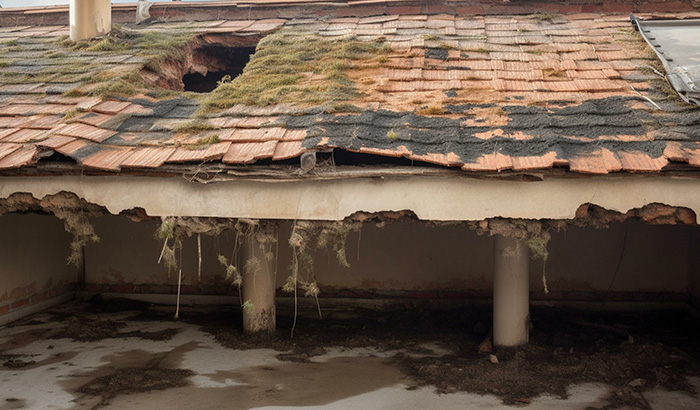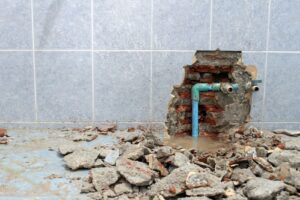A water damage inspection is a comprehensive evaluation of a property’s condition. It focuses on the extent of water-related damage, its causes, and potential risks. This assessment aids property owners, insurance companies, and restoration professionals in understanding the damage’s scope and formulating appropriate repair and restoration strategies.
In this article, we will tell you everything you need to know about a water damage inspection and what the most common causes of water damage are.
First up, here’s everything you need to know about water damage inspections:
- Purpose and Significance: Water damage inspections serve the crucial purpose of identifying, documenting, and assessing the impact of water infiltration on a property. This aids in devising effective restoration plans and preventing further deterioration.
- Categories of Water Damage: Inspections consider the three main categories of water damage: clean water (Category 1), grey water (Category 2), and black water (Category 3). Each category poses varying levels of contamination and potential health risks.
- Sources of Water Damage: Water damage can stem from diverse sources, such as plumbing leaks, faulty appliances, roof leaks, foundation cracks, sewer backups, and natural disasters like floods or storms.
- Interior and Exterior Inspection: A thorough examination encompasses the property’s interior and exterior. This includes checking for signs of leaks, stains, dampness, mold growth, and other indications of water infiltration.
- Advanced Inspection Tools: Moisture meters, thermal imaging cameras, hygrometers, and fiber optic cameras are employed to identify hidden moisture pockets, water pathways, and areas of potential damage within walls, ceilings, and floors.
- Severity Grading and Categorization: Water damage is classified into levels based on severity. This ranges from minor surface moisture and staining to significant structural damage requiring immediate attention.
- Mold Evaluation and Testing: Inspectors assess the presence of mold, examining areas prone to growth due to elevated moisture levels. They might conduct air and surface tests to identify mold spores and provide insights into potential health risks.
- Health Implications: Water damage can lead to the growth of mold, bacteria, and pathogens, potentially causing respiratory issues, allergies, and other health concerns. Inspections shed light on the health risks associated with the damage.
- Documentation and Reporting: Inspection reports are comprehensive documents that include detailed descriptions of damage, photographs, diagrams, moisture readings, and potential causes. These inspection reports are essential for insurance claims and restoration processes.
- Electrical System Assessment: Water infiltration can compromise electrical systems, posing fire and electrocution hazards. Inspections help identify potential electrical issues and recommend necessary repairs.
- Structural Analysis: Inspectors scrutinize the structural integrity of the property, examining the impact of water damage on the foundation, walls, flooring, and roof. This assessment is crucial for assessing safety concerns and planning repairs.
- Content Evaluation: Apart from the property’s structure, inspectors assess the damage to personal belongings, furniture, and valuable items, aiding in determining compensation for insurance claims.
- Preventive Measures and Recommendations: Inspectors provide actionable recommendations to prevent future water damage. This could involve improving drainage systems, sealing cracks, insulating pipes, and installing sump pumps.
- Insurance Claims Support: Detailed inspection reports are invaluable when filing insurance claims. They provide evidence of the extent of damage and can lead to fair compensation for restoration efforts.
- Timely Repairs and Restoration: Early detection through inspections facilitates prompt and appropriate repairs. This prevents minor issues from escalating into major, costly structural problems and reduces overall restoration expenses.
- Monitoring Drying Processes: If water removal and drying are necessary, inspectors monitor the effectiveness of these processes to ensure that no residual moisture remains, which could lead to further damage or mold growth.
- Hidden Damage Detection: Inspectors employ specialized tools to detect hidden moisture in hard-to-reach areas. This includes using thermal imaging cameras to identify temperature variations indicative of hidden water.
- Expertise and Certification: Certified water damage inspectors possess the expertise to identify even subtle signs of water damage. Their training equips them to perform accurate and comprehensive assessments.
- Impact on Indoor Air Quality: Water damage can adversely affect indoor air quality due to mold spores and pollutants. Inspections assess the potential impact on the air the occupants breathe.
- Long-Term Implications and Property Value: Neglected water damage can lead to chronic structural degradation, decreased property value, and persistent health concerns. Effective inspections and timely repairs mitigate these long-term risks, preserving property integrity and occupant health.
Water damage inspections extend far beyond surface-level assessments. They delve into the intricacies of property damage, health risks, and structural integrity. Certified inspectors provide detailed reports and recommendations by employing advanced tools and techniques, contributing to informed decision-making, effective repairs, and overall property well-being.
Next up, here are the most common reasons for water damage:
- Plumbing Issues: Burst pipes often result from freezing temperatures causing water inside pipes to expand and rupture. Leaking pipes can stem from corrosion, deteriorated pipe fittings, or excessive water pressure. Faulty plumbing fixtures, such as faucets and toilet valves, can also lead to slow leaks that cause water damage over time.
- Roof Leaks: Damaged or missing roof shingles, cracked flashing, and improperly sealed roof penetrations like vents and chimneys can allow rainwater to infiltrate the building. Water can seep through the roof, damaging ceilings, walls, and insulation.
- Appliance Failures: Appliances like washing machines, dishwashers, water heaters, and refrigerators have water supply lines and drainage systems that can fail. These failures can lead to leaks and flooding, causing damage to nearby areas and potentially requiring extensive cleanup and repairs.
- Foundation Cracks: Cracks in a building’s foundation can allow groundwater to seep into basements or crawl spaces. This can lead to flooding, dampness, and mold growth, compromising the property’s structural integrity.
- Sewer Backups: Blockages, tree root invasions, or overloaded municipal sewer systems can cause sewage to back up into homes or businesses. This situation poses health hazards due to the contamination and requires immediate attention to prevent further damage.
- Storms and Flooding: Heavy rainfall, hurricanes, and other severe weather events can cause flooding. Floodwater can enter buildings, damaging walls, floors, and belongings. In addition to water damage, floodwater can carry contaminants and pose health risks.
- Poor Drainage: Incorrect grading around the property, clogged gutters, and inadequate drainage systems can cause water to accumulate near the foundation. This can lead to water infiltration and potential foundation damage over time.
- Window and Door Leaks: Insufficiently sealed windows and doors can allow rainwater to seep indoors, potentially damaging walls, floors, and nearby structures. This can also create an environment conducive to mold growth.
- HVAC System Issues: HVAC systems can produce condensation as they cool warm air. If not properly drained, this condensation can accumulate, leading to water damage and promoting mold growth if left unchecked.
- Basement Seepage: Hydrostatic pressure from groundwater can force water through basement walls and floors. This seepage can lead to dampness, mold, and degradation of the basement’s structural integrity.
- Lack of Maintenance: Neglecting regular maintenance of roofing, plumbing systems, and drainage infrastructure can exacerbate the risk of water damage. Regular inspections and upkeep can help identify and address potential issues before they escalate.
- Construction Defects: Poorly executed construction or inadequate waterproofing measures during building construction can result in chronic water infiltration and damage. These issues might not become apparent until after the property is in use.
- Landscape Grading: Improper landscape grading can cause water to flow toward the building rather than away. This can lead to water pooling near the foundation, increasing the risk of water infiltration.
- Natural Disasters: Earthquakes, wildfires, and other natural disasters can lead to water damage indirectly. Fire suppression efforts can cause water damage, and compromised infrastructure can result in flooding.
- Leaking Water Heaters: Water heaters can leak due to rust, corrosion, or a malfunctioning pressure relief valve. Such leaks can lead to flooding and damage in the area surrounding the water heater.
- Blocked Drains: Blockages in drainage systems, such as sinks, toilets, or main sewer lines, can cause backups and water damage. This can result in the overflow of wastewater, creating unsanitary conditions.
- Condensation: In areas with high humidity or inadequate ventilation, condensation can accumulate on surfaces like windows, walls, and ceilings. Over time, this can lead to water damage and create an environment conducive to mold growth.
- Malfunctioning Sump Pumps: Sump pumps installed in basements or crawl spaces are designed to prevent flooding by pumping out excess groundwater. If these pumps fail or aren’t properly maintained, flooding can occur during heavy rainfall or melting snow.
- Human Error: Accidents like leaving faucets running, overflowing bathtubs, or neglecting to turn off water sources can lead to unintended water damage. Quick response and cleanup are essential to mitigate the damage in such cases.
Understanding these common reasons for water damage can help homeowners and businesses take preventive measures to minimize the risks and respond effectively when such incidents occur.
Let Utah Disaster Clean Up & Restoration Take Care of Your Water Damage
After over 20 years of experience, Utah Disaster Clean Up and Restoration knows how to clean up water damage. We strive to do our best to restore and reconstruct your home to its former glory. Our fast and friendly service will get you through this stressful experience quickly and seamlessly.
Contact Utah Disaster Clean Up & Restoration today, and let our trained professionals take charge of your water damage restoration.



